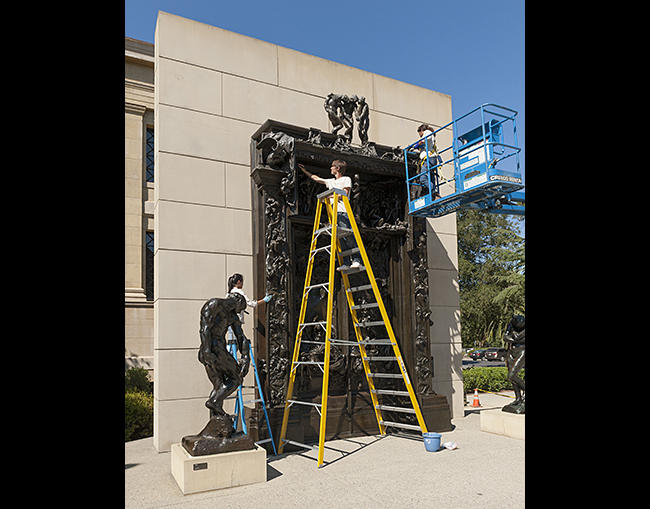
Can’t resist touching the art? These Stanford students scrub the ‘Gates of Hell’
Check out one of the coolest jobs on the Stanford campus: outdoor sculpture conservation technician.
Somebody has got to keep the Gates of Hell safe from the elements. Meet the students on Stanford’s outdoor sculpture preservation crew. They conduct preventative maintenance on Rodin’s Gates of Hell and 100 other outdoor sculptures across campus. In other words, they get lots of hands-on-the-art experience because they have permission to touch.
Given the nature of their work, which combines art and science, it’s no surprise that the crew, led by Elizabeth Saetta, is an extension of the Cantor Arts Center’s Art+Science Learning Lab, run by Susan Roberts-Manganelli.

L.A. Cicero
Saetta points out in a post on the Cantor blog Cross-Sections that conservation of art, including outdoor sculpture, involves specific training in not only art, but also chemistry and materials science.
Past technicians have in fact included students studying art history, chemistry and materials science, as well as bio-engineering, philosophy, English, mathematics and studio art.
The crew trains with Saetta by learning about patinas, anionic soap and brush types, as well as the damaging properties of bird droppings, pollution and even water. On the logistical side, they help arrange for the fencing, water, electricity and lifts the workers need to do their job.
Then there is the Art Cart, a golf cart-type vehicle initially outfitted by the museum staff around 2003. It hauls crews and supplies around campus to accomplish constant preventative maintenance, as well as to deal with the latest conservation treatment issues (i.e., graffiti or metal corrosion). The d.school recently presented a clever upgrade improving functionality and visibility of the preservation program.
Recently the Gates of Hell were washed with gentle detergent and soft brushes, then dried to prevent mineral deposits. Once dry, a protective microcrystalline coating was applied to the surface with brushes and lint-free cotton rags. The application was done during the heat of the afternoon sun and with a small propane torch to warm the surface and allow for an even coating of wax onto the metal surface.
“Regular care protects the sculpture from exposure to the elements, pests and public, and also prevents the need for invasive conservation treatment or repairs in the future,” Saetta said. She is currently seeking a hands-on student to join the crew – one who’s not afraid of waxing hell.
